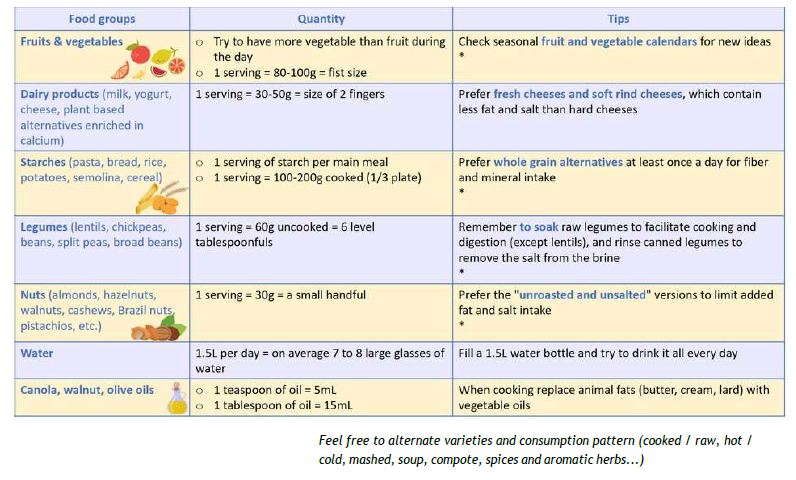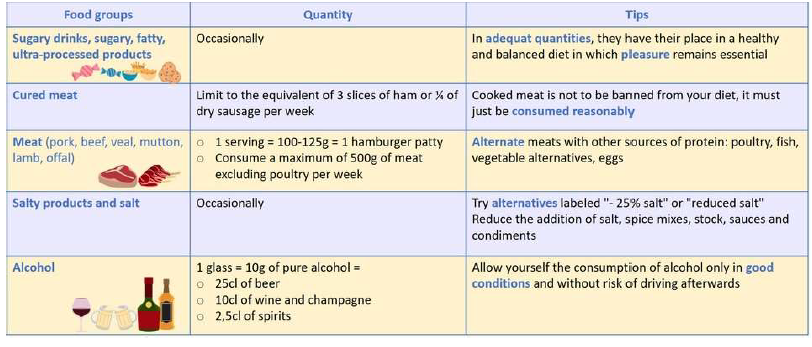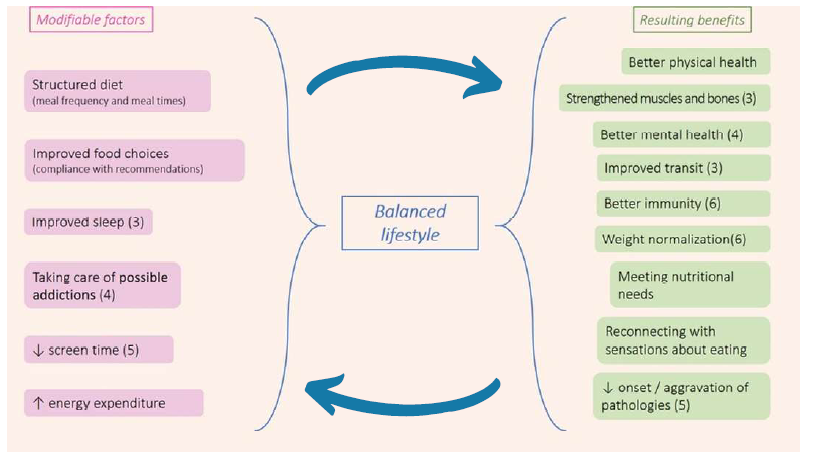Lifestyle and diet
Source : Nutriactis/Rouen-Normandie hospital
Summary
- Introduction
- Reminder of the recommendations
- To promote
- To limit
- What about physical activity?
- The benefits of a balanced lifestyle
- Conclusion / Source
Introduction
A healthy lifestyle is defined as the balance between good physical and mental health, involving diet, physical activity, and lifestyle habits (sleep, addictions). Balancing one’s lifestyle can reduce the onset of various pathologies, or limit the development of existing ones (diabetes, obesity, eating disorders, anxiety, depression, cardiovascular diseases, etc. quite a long list!). Throughout this article, you will discover (or rediscover) the basics of a balanced lifestyle, how to integrate them into your daily life, and its beneficial effects on eating behavior and quality of life.
Reminder of the recommendations
First of all, it seems relevant to review the current and official recommendations for healthy eating and physical activity issued by Health Authorities (1). These recommendations are averages determined for an average adult without taking into account physical activity or any potential health problems. It is important to underline that there are no “good” and “bad” foods; they all important in a balanced diet, provided that they are consumed in the adequate quantities and at the right frequency. For this reason, the recommendations are divided into “foods to promote” and “foods to avoid” with a sub-section dedicated to physical activity.
These numerous recommendations can sometimes make your head spin, and seem difficult to integrate in our day-to-day lives. However, with our tips, good organization, and some effort, you will see that it is not mission impossible !
Below, we will review each recommendation and how to put it into practice.

To promote:

In practice

To limit

In practice

What about physical activity?

In practice

The benefits of a balanced lifestyle
By choosing a healthy diet that covers nutritional needs, increasing energy expenditure, and respecting one’s internal clock, several positive effects will appear quickly. A balanced lifestyle will not only have effects on eating behavior and weight but also has many other benefits such as an improved mental health and transit.

At first sight, it may seem laborious to implement all of these recommendations and change one’s lifestyle. However, it should be noted that each resulting benefit will facilitate the process by initiating a virtuous circle. For example: structuring your diet (3 meals and 1 snack) → improvement of your sleep → energy gain → increasing your physical activity with less effort → improvement of your sleep → etc…
It is therefore up to each individual to determine where they feel capable of making the first efforts among the list of modifiable factors. The benefits that will result from these first efforts will then facilitate the work on the remaining parameters. If you try to rebalance all the parameters at once, the process may seem overwhelming and you may end up feeling disappointed and frustrated. It is essential to take your time in making behavioral changes in order to establish a lasting change in lifestyle!
To learn more and deepen your knowledge of healthy eating, do not hesitate to consult the NutriActis guide for a healthy and balanced diet available on the website!
Conclusion
- Therefore, a balanced lifestyle depends on diet, physical activity and lifestyle. However, we must not neglect the importance of pleasure in this balance. These recommendations should be followed without restricting your diet and depriving yourself.
- The body has the ability to balance itself over several weeks, so you may enjoy that larger meal, that second dessert, or that slice of cake from time to time, without fear of disturbing your lifestyle.
- The best eating habits include food choices that match your :
- Taste
- Budget
- Culture
- Way of life
-
Download this article in PDF form
pdf – 2 MB